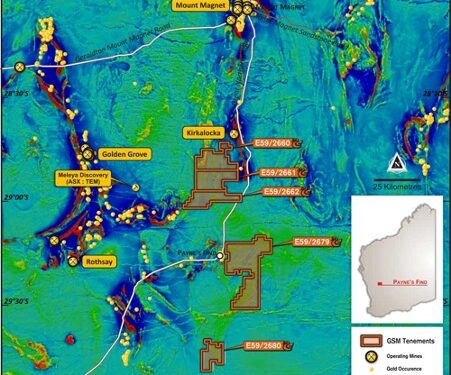Golden State Mining Limited (ASX: GSM) has identified coherent lithium anomalism up to 217ppm – with pathfinder element support – at the Paynes Find lithium project in the Murchison Region of Western Australia.
“This first phase of work has provided encouraging lithium results at our Paynes Find project so early in 2023, giving GSM great momentum for the field season ahead,” Managing Director, Michael Moore, said.
“This outcome also provides vectors for drill targeting at the project later in the year. With just over 14% of the project area covered in this first round of work, we still have a significant amount ground to evaluate, and it’s great to report that this important work has already commenced.
“In addition, these selective areas do not include higher priority structural targets, based on aeromagnetic signatures with interpreted deeper cover where drill testing will be required.”
The company has received and interpreted ultrafine soil assay results from its first phase regional geochemical sampling at its Paynes Find project. A total of 683 soil samples were collected by independent contractors for analysis of the ultrafine fraction (<2μm) over a number of regional grids on 400m centres along 800m spaced, east-west orientated lines. These grids were located over areas interpreted to encompass relatively shallow regolith cover considered amenable to this sampling methodology and best suited to deliver any potential basement response. The total sampling area completed to date represents only 14.4% of the granted tenure at the Paynes Find project.
These selective areas do not include higher priority structural targets which are based on aeromagnetic signatures with interpreted deeper cover where drill testing will be required.
A lithium pegmatite targeting exercise was completed by an independent geochemist using various statistical grouping and leveling methods of the multi-element assay data. Statistical grouping used a weighted sum methodology, calculated from known economic and selected supporting elements for LCT pegmatite mineralization styles. The levelling methods mitigated the effects of any assay batch variation and regolith control.
The resultant >90th percentile sample population has highlighted areas showing anomalous lithium (Li) values which are supported by other pathfinder elements including beryllium (Be), caesium (Cs), niobium (Nb), rubidium (Rb), tin (Sn) & tantalum (Ta). The coherent occurrences of elevated Li-Rb-Cs together is considered particularly significant as a regional indicator for the presence of LCT pegmatite mineralization. These group 1 alkali elements have a similar chemistry in surficial environments and are known to occur together in a pegmatite related setting.
This process has identified 29 initial areas of interest which have been ranked in order of priority for follow up work.
The highest priority area for soil infill is located on the western side of the central tenement area (E59/2679) within a 6.7 sq. km area of contiguous samples anomalous in lithium with supporting elements including Cs, Rb and Ta along a six km north-north-easterly trend. The highest lithium assay recorded at this location was 217ppm in sample PFX0669 along with 16.5ppm Cs, and 217ppm Rb.
The remaining priority infill soil targets consist of clusters of lower priority areas of interest which will be completed later in
the year. Data analysis and target generation for base metal potential is ongoing.
Next steps
Infill soil sampling has already commenced over the two priority target areas with an estimated completion by the end of March. Assay results for this infill campaign are expected early May at this stage. The results and interpretation will then be incorporated with field mapping work planned for May 2023 in preparation for potential drilling planned for early July 2023.
For further information please visit: https://goldenstatemining.com.au/












